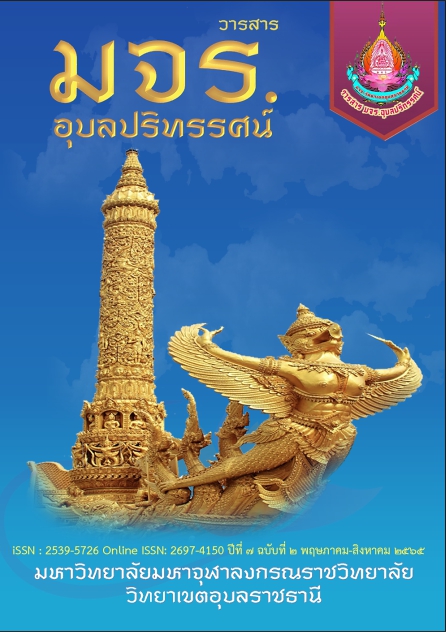AN ADMINISTRATION BASED ON THE SEVEN PRINCIPLES OF SAPPURISADHAMMAS MODEL THE GENERAL EDUCATION SECTION OF PHRAPARIYATTIDHAMMA SCOOLS AREA 7
Main Article Content
Abstract
The objectives of this research were: 1) to study the current condition, desirable conditions, and needs of the administration of Phrapariyattidhamma Schools, General Education, Area 7; 2) to develop an administrative model according to the Seven Sappurisadhamma of Phrapariyattidhamma Schools, General Education, Area 7; 3) to assess the administrative model as mentioned. This study was carried out by means of mixed-method research between quantitative and qualitative research. The research instruments consisted of a questionnaire, a semi-structured interview form, and the model’s suitability, feasibility, and usefulness assessment form. The sample group consisted of 175 school administrators and teachers in quantitative research. The statistics used were: Frequency, Percentage, Mean and Standard Deviation. The research results were as follows: 1) The current condition, desirable conditions, and needs of the administration of the Phrapariyattidhamma Schools above: the mean value of the desirable conditions was higher than the current condition in all aspects and issues. The overall mean was statistically rated at the highest level. Sorted in order of importance of the needs based on the determination from the PNI values were as follows: (1) personnel administration according to the Seven Sappurisadhamma; (2) general administration according to the Seven Sappurisadhamma; (3) budget administration according to the Seven Sappurisadhamma; (4) academic administration according to the Seven Sappurisadhamma. 2) The result of the development of the administrative model according to the Seven Sappurisadhamma of the Phrapariyattidhamma Schools, as mentioned, suggested that the model should consist of (1) Dhammaññutā (knowing the law); (2) Atthaññutā (knowing the purpose), (3) Attaññutā (knowing oneself), (4) Mattaññutā (moderation); (5) Kāluññuta (knowing the proper time); (6) Parisaññutā (knowing the society0; (7) Puggalaññutā (knowing the individual). 3) From the assessment results of the administrative model according to the Seven Sappurisadhamma of Phrapariyattidhamma Schools, General Education, Area 7, it was found that the model’s suitability, feasibility, and usefulness were overall rated at a high level. This model indeed can be used in the actual development.
Article Details
References
พระมหาปัญญา ปญฺาสิริ (ลักษณะจันทร์). (2557) ประสิทธิผลการบริหารจัดการโรงเรียนพระปริยัติธรรม แผนกสามัญศึกษา ในเขตปกครองคณะสงฆ์ภาค 2. บัณฑิตวิทยาลัย : มหาวิทยาลัยมหาจุฬาลงกรณราชวิทยาลัย,
พระครูปลัดจักรพันธ์ ปญฺาธโร.(2559) ปัจจัยที่ส่งผลต่อความสาเร็จในการบริหารโรงเรียนพระปริยัติธรรมแผนกสามัญศึกษา บัณฑิตวิทยาลัย: มหาวิทยาลัยมหาจุฬาลงกรณราชวิทยาลัย,
พระครูศรีสุธรรมนิวิฐ (ธานี สุขโชโต) (2560).กระบวนการการบริหารงานบุคคลของมหาวิทยาลัยมหาจุฬาลงกรณราชวิทยาลัยตามหลักพุทธบริหารการศึกษา”. บัณฑิตวิทยาลัย: มหาวิทยาลัยมหาจุฬาลงกรณราชวิทยาลัย,
พระครูโกศลอรรถกิจ.(2559) “รูปแบบการบริหารจัดการโรงเรียนพระปริยัติธรรม แผนกสามัญศึกษาในจังหวัดนครศรีธรรมราช ตามแนวพุทธปรัชญาเถรวาท”. บัณฑิตวิทยาลัย: มหาวิทยาลัยมหามกุฏราชวิทยาลัย,
พระมหาภาณุวัฒน์ แสนคา และ สมชาย บุณศิริเภสัช. (2558) “การบริหารตามหลักสัปปุริสธรรม 7 ของผู้บริหารโรงเรียนพระปริยัติธรรมแผนกสามัญศึกษา จังหวัดลาปาง”. บัณฑิตวิทยาลัย : มหาวิทยาลัยราชภัฏลาปาง,
พระมหาอานนท์ ชวนาภิภู (แสนแป้). (2560) “รูปแบบการพัฒนาสมรรถนะหลักของบุคลากรตามหลักพุทธธรรม ของโรงเรียนพระปริยัติธรรม แผนกสามัญศึกษา”. บัณฑิตวิทยาลัย: มหาวิทยาลัยมหาจุฬาลงกรณราชวิทยาลัย,
โรงเรียนพระปริยัติธรรม แผนกสามัญศึกษา จังหวัดขอนแก่น. (2563).รายงานประจำปี 2561. อ้างใน พระครูวินัยธรสุวรรณ สุวรรณโณ(เรืองเดช) และวิเชียร รู้ยืนยง. “แนวทางการบริหารงานบุคคลของโรงเรียนพระปริยัติธรรม แผนกสามัญศึกษา จังหวัดขอนแก่น”. วารสารพุทธปรัชญาวิวัฒน์ ปี่ที่ 4 ฉบับที่ (กรกฎาคม – ธันวาคม
วันทนา เนาว์วัน. (2557) “การพัฒนาภาวะผู้นำตามหลักพุทธธรรมของบุคลากร โรงเรียนพระปริยัติธรรมแผนกสามัญศึกษากลุ่ม 3”. บัณฑิตวิทยาลัย: มหาวิทยาลัยมหาจุฬาลงกรณราชวิทยาลัย,

